
Larus is a large genus of gulls with worldwide distribution.

The common gull is a medium-sized gull that breeds in cool temperate regions of the Palearctic from Iceland and Scotland east to Kamchatka in the Russian Far East. Most common gulls migrate further south in winter, reaching the Mediterranean Sea, the southern Caspian Sea, and the seas around China and Japan; northwest European populations are at least partly resident. The closely related short-billed gull was formerly often included in this species, which was then sometimes known collectively as "mew gull".

The European herring gull is a large gull, up to 66 cm (26 in) long. It breeds throughout the northern and western coasts of Europe. Some European herring gulls, especially those resident in colder areas, migrate further south in winter, but many are permanent residents, such as in Ireland, Britain, Iceland, or on the North Sea shores. They have a varied diet, including fish, crustaceans, as well as some plants, and are also scavengers, consuming carrion and food left by or stolen from humans.

The great black-backed gull is the largest member of the gull family. It is a very aggressive hunter, pirate, and scavenger which breeds on the coasts and islands of the North Atlantic in northern Europe and northeastern North America. Southern populations are generally sedentary, while those breeding in the far north move farther south in winter. A few also move inland to large lakes and reservoirs. The adult has a white head, neck and underparts, dark blackish-grey wings and back, pink legs and the bill yellow with a red spot.

The lesser black-backed gull is a large gull that breeds on the Atlantic coasts of Europe. It is migratory, wintering from the British Isles south to West Africa. However, it has increased dramatically in North America, especially along the east coast. Formerly just a winter visitor to North America, it has increased and occurs in large numbers some winters and birds are now recorded year-round. However, there is serious concern about decline in many parts of its range. The species is on the UK Amber List because the UK is home to 40 per cent of the European population and more than half of these are found at fewer than ten breeding sites.

The little gull, is a species of gull belonging to the family Laridae which is mainly found in the Palearctic with some colonies in North America. It breeds on freshwaters and spends winters at sea. It is the smallest species of gull in the world and the only species in the monospecific genus Hydrocoloeus.

The Iceland gull is a medium-sized gull that breeds in the Arctic regions of Canada and Greenland, but not in Iceland, where it is only seen during winter. The genus name is from Latin larus, which appears to have referred to a gull or other large seabird. The specific name glaucoides denotes its resemblance to Larus glaucus, a synonym of Larus hyperboreus, the glaucous gull; -oides is Ancient Greek and means "resembling".

The yellow-legged gull is a large gull found in Europe, the Middle East and North Africa, which has only recently achieved wide recognition as a distinct species. It was formerly treated as a subspecies of either the Caspian gull L. cachinnans, or more broadly as a subspecies of the herring gull L. argentatus. The genus name is from Latin Larus which appears to have referred to a gull or other large seabird, and the species name honours the German zoologist Karl Michahelles.

The Caspian gull is a large gull and a member of the herring and lesser black-backed gull complex. The scientific name is from Latin. Larus appears to have referred to a gull or other large seabird, and cachinnans means 'laughing', from cachinnare 'to laugh'.

The silver gull is a gull in Oceania. It is the most common gull of Australia. It has been found throughout the continent, but particularly at or near coastal areas. It is smaller than the Pacific gull, which also lives in Australia.

The California gull is a medium-sized gull, smaller on average than the herring gull, but larger on average than the ring-billed gull. Although named after California, it can be found annually across most of western North America, from the Canadian prairie provinces in the northeast and south through western Mexico.
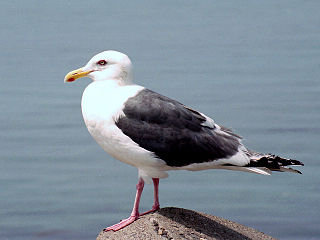
The slaty-backed gull is a large, white-headed gull that breeds on the north-eastern coast of the Palearctic, but travels widely during nonbreeding seasons. It is similar in appearance to the western gull and the glaucous-winged gull. Another alternate name is Pacific gull, though it also applies to a Southern Hemisphere species, L. pacificus.
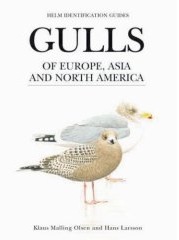
Gulls of Europe, Asia and North America by Klaus Malling Olsen and Hans Larsson is a volume in the Helm Identification Guides series of bird identification books.
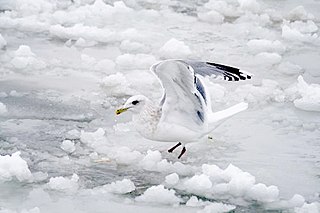
Thayer's gull is a subspecies of the Iceland gull. It is a large gull native to North America.
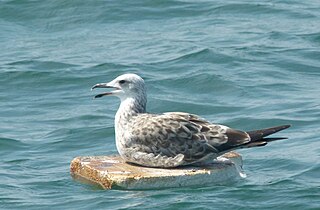
Heuglin's gull or the Siberian gull, is a seabird in the genus Larus.
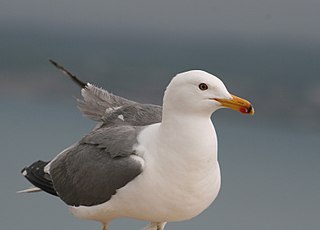
The Armenian gull is a large gull found in the Caucasus and the Middle East. It was formerly classified as a subspecies of the European herring gull, but is now generally considered to be a separate species, although BirdLife International lumps it with the yellow-legged gull.

The Vega gull, East Siberian gull, or East Siberian herring gull is a large gull of the herring gull/lesser black-backed gull complex which breeds in Northeast Asia. Its classification is still controversial and uncertain. It is variously treated as a separate species, as a subspecies of the American herring gull or included with both the American herring gull and European herring gull in L. argentatus. The Mongolian gull Larus mongolicus was formerly regarded as a subspecies of Vega gull. It was described in 1887 from specimens collected on the 1878–1880 Vega Expedition on the Swedish ship SS Vega.

The American herring gull or Smithsonian gull is a large gull that breeds in North America, where it is treated by the American Ornithological Society as a subspecies of herring gull.
Herring gull is a common name for several birds in the genus Larus, all formerly treated as a single species.



















